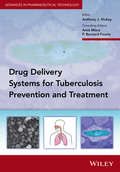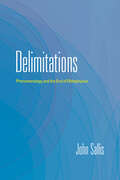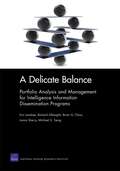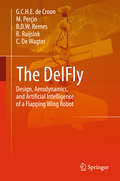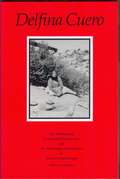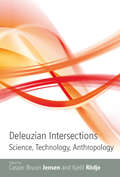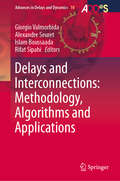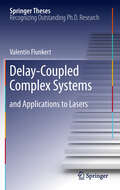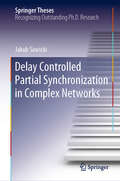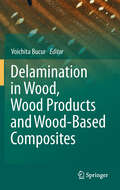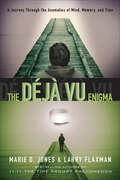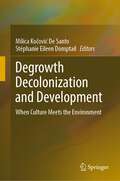- Table View
- List View
Delmar's Standard Textbook of Electricity
by Stephen L. HermanMastering the theory and application of electrical concepts is necessary for a successful career in the electrical installation or industrial maintenance fields, and this new fifth edition of DELMAR'S STANDARD TEXTBOOK OF ELECTRICITY delivers! Designed to teach by blending concepts relating to electrical theory and principles with practical 'how to' information that prepares you for situations commonly encountered on the job. Topics span all the major aspects of the electrical field including atomic structure and basic electricity, direct and alternating current, basic circuit theory, three-phase circuits, single phase, transformers, generators, and motors. This revision retains all the hallmarks of our market-leading prior editions and includes enhancements such as updates to the 2011 NECr, a new chapter on industry orientation, and new coverage of constant-current transformers and fuel cells as well as reference tips on going green throughout the text.
Delivery Systems for Tuberculosis Prevention and Treatment
by P. Bernard Fourie Anthony J. Hickey Amit MisraProvides a review of novel pharmaceutical approaches for Tuberculosis drugs Presents a novel perspective on tuberculosis prevention and treatment Considers the nature of disease, immunological responses, vaccine and drug delivery, disposition and response Multidisciplinary appeal, with contributions from microbiology, immunology, molecular biology, pharmaceutics, pharmacokinetics, chemical and mechanical engineering
Delivery and Mixing in the Subsurface
by Peter K. Kitanidis Perry L. MccartyThis volume is meant to provide the practitioner with information on the natural mixing processes occurring in aquifers as well as to describe basic strategies that can be implemented to enhance mixing in particular cases. For example, when it comes to mixing miscible liquids, one can speed up mixing in the formation by manipulating the flow such as through the use of recirculation wells. Furthermore, much of the mixing can be achieved partially within recirculation wells themselves, where contaminated water is admixed with additives, volatile products may be removed through a vapor mass exchanger, etc. Thus, adding mixing wells can significantly increase the performance of the delivery and mixing system and speed up the process of remediation.
Delivering Police Services Effectively (Advances in Police Theory and Practice #27)
by Garth den HeyerThis book addresses the various strategies that are available to police management, such as consolidation, regionalization, and amalgamation of police agencies; new public management (NPM); enhanced performance management; civilianization; and organizational restructuring. It fills the gap in the research as to how police agencies have reacted to the environmental and fiscal changes since the 1980s. The book examines the strategies employed and the effect on police and their delivery of service.
Delivering Functionality in Foods: From Structure Design to Product Engineering (Food Engineering Series)
by António Vicente Cristina Silva Chelo GonzalezThis singular text aims to strengthen the scientific understanding of food product design and engineering, and to stimulate and accelerate the development of innovative, complex and highly structured products and suitable production processes. By gathering an interdisciplinary team of scientists from the research areas of food engineering, biophysics, applied soft matter, food technology and applied human nutrition, this book contributes to an integrated process and product design approach for creating innovative, multi-phase structured foods delivering functionality.Delivering functionality in foods: from structure design to product engineering serves as an important reference for food engineers, food technologists and nutritionists, covering all aspects of the design of food structures and their application in the development of functional food products. From the delivery of health-related functionalities to process and product engineering for delivery of multiple food properties, this work provides a comprehensive overview of the knowledge, processes and technologies required for the design of functional foods.
Delineating Organs at Risk in Radiation Therapy
by Giampiero Ausili Cèfaro Domenico Genovesi Carlos A. PerezDefining organs at risk is a crucial task for radiation oncologists when aiming to optimize the benefit of radiation therapy, with delivery of the maximum dose to the tumor volume while sparing healthy tissues. This book will prove an invaluable guide to the delineation of organs at risk of toxicity in patients undergoing radiotherapy. The first and second sections address the anatomy of organs at risk, discuss the pathophysiology of radiation-induced damage, and present dose constraints and methods for target volume delineation. The third section is devoted to the radiological anatomy of organs at risk as seen on typical radiotherapy planning CT scans, with a view to assisting the radiation oncologist to recognize and delineate these organs for each anatomical region – head and neck, mediastinum, abdomen, and pelvis. The book is intended both for young radiation oncologists still in training and for their senior colleagues wishing to reduce intra-institutional variations in practice and thereby to standardize the definition of clinical target volumes.
Delimitations: Phenomenology and the End of Metaphysics (The Collected Writings of John Sallis)
by John SallisSince Hegel, philosophers have declared repeatedly that metaphysics is at an end, a pronouncement that has sparked much contemporary philosophical debate. What exactly does the end, or closure, of metaphysics mean, and what are the implications of this view?John Sallis characterizes the end of metaphysics as a limit, or horizon, both enclosing metaphysical thought and opening the field of thinking beyond it. He elaborates five areas in which the boundaries of thinking are extended: imagination as an opening power, the radicalizing of phenomenology's injunction to attend to the things themselves, Heidegger's shift of thinking toward an opening or clearing, archaic closure through a return to Plato and Heraclitus, and the nonidentity that takes place in the act of delimitation. This last question is developed in relation to Husserl's project of a pure phenomenology, to the debate between hermeneutics and deconstruction, and to the secluding of ground announced in Schelling's thought.
Delicious: The Evolution of Flavor and How It Made Us Human
by Rob Dunn Monica SanchezA savory account of how the pursuit of delicious foods shaped human evolutionNature, it has been said, invites us to eat by appetite and rewards by flavor. But what exactly are flavors? Why are some so pleasing while others are not? Delicious is a supremely entertaining foray into the heart of such questions.With generous helpings of warmth and wit, Rob Dunn and Monica Sanchez offer bold new perspectives on why food is enjoyable and how the pursuit of delicious flavors has guided the course of human history. They consider the role that flavor may have played in the invention of the first tools, the extinction of giant mammals, the evolution of the world’s most delicious and fatty fruits, the creation of beer, and our own sociality. Along the way, you will learn about the taste receptors you didn't even know you had, the best way to ferment a mastodon, the relationship between Paleolithic art and cheese, and much more.Blending irresistible storytelling with the latest science, Delicious is a deep history of flavor that will transform the way you think about human evolution and the gustatory pleasures of the foods we eat.
A Delicate Balance
by Michael S. Tseng Brian G. Chow Eric Landree Lance Sherry Richard SilberglittThis description of the application of the RAND Corporation's PortMan portfolio analysis and management method and Delphi consensus-building method for the National Security Agency (NSA) Information Sharing Services (ISS) division highlights how these methods enable the data-driven analysis of project portfolios and the allocation of research and development (R&D) and operations and maintenance (O&M) resources according to value, risk, and cost.
The DelFly
by C. Wagter R. Ruijsink B. D. W. Remes M. Perçin G. C. H. E. CroonThis book introduces the topics most relevant to autonomously flying flapping wing robots: flapping-wing design, aerodynamics, and artificial intelligence. Readers can explore these topics in the context of the "Delfly", a flapping wing robot designed at Delft University in The Netherlands. How are tiny fruit flies able to lift their weight, avoid obstacles and predators, and find food or shelter? The first step in emulating this is the creation of a micro flapping wing robot that flies by itself. The challenges are considerable: the design and aerodynamics of flapping wings are still active areas of scientific research, whilst artificial intelligence is subject to extreme limitations deriving from the few sensors and minimal processing onboard. This book conveys the essential insights that lie behind success such as the DelFly Micro and the DelFly Explorer. The DelFly Micro, with its 3. 07 grams and 10 cm wing span, is still the smallest flapping wing MAV in the world carrying a camera, whilst the DelFly Explorer is the world's first flapping wing MAV that is able to fly completely autonomously in unknown environments. The DelFly project started in 2005 and ever since has served as inspiration, not only to many scientific flapping wing studies, but also the design of flapping wing toys. The combination of introductions to relevant fields, practical insights and scientific experiments from the DelFly project make this book a must-read for all flapping wing enthusiasts, be they students, researchers, or engineers.
Delfina Cuero: Her Autobiography, An Account Of Her Last Years And Her Ethnobotanic Contributions (Anthropological Papers #38)
by Florence C. Shipek Sylvia B. VaneDelfina Cuero: Her Autobiography, an Account of Her Last Years, and Her Ethnobotanic Contributions
Deleuzian Intersections
by Casper Bruun Jensen Kjetil RodjeScience and technology studies, cultural anthropology and cultural studies deal with the complex relations between material, symbolic, technical and political practices. In a Deleuzian approach these relations are seen as produced in heterogeneous assemblages, moving across distinctions such as the human and non-human or the material and ideal. This volume outlines a Deleuzian approach to analyzing science, culture and politics.
Deleuze and the Non/Human
by Jon Roffe Hannah StarkDeleuze and the Non/Human brings together leading international voices to consider the place of the philosophy of Gilles Deleuze in the nonhuman turn. It examines recent debates about the figure of the nonhuman in fields such as new materialism, speculative realism, animal studies, and the environmental and ecological Humanities and scrutinizes the debt to Deleuze's work that is evident in these emerging fields. Accordingly, the contributors to the volume are drawn from across the academy. Deleuze's philosophy already anticipated many of the current debates about the non/human. The proposed volume continues this engagement, extending some of these lines of investigation, in disciplines such architecture, literary studies, gender studies, philosophy, geography and cultural studies. At the same time, its goal is to open up a critical line of questioning about what the nonhuman means in Deleuze's work itself. Deleuze and the Non/Human is thus both about the non/human from Deleuze's point of view, and about Deleuze from the point of view of the various problematics that can be included in the nonhuman turn. Deleuze and the Non/Human makes a timely intervention in a broad set of interdisciplinary debates, and demonstrates once again the force of Deleuze's philosophy for our critical examination of the contemporary condition.
Deleuze And Anarchism (Deleuze Connections)
by Chantelle Heerden Aragorn EloffExplores Deleuze and Guattari's own diverse conceptions of anarchism and expands it in the spirit of their philosophy <p><p> This collection of 13 essays addresses and explores Deleuze and Guattari's relationship to the notion of anarchism: in the diverse ways that they conceived of and referred to it throughout their work, and also more broadly in terms of the spirit of their philosophy and in their critique of capitalism and the State. <p> Both Deleuze and Guattari were deeply affected by the events of May '68 and an anarchist sensibility permeates their philosophy. However, they never explicitly sustained a discussion of anarchism in their work. Their concept of anarchism is diverse and they referred to in very different senses throughout their writings. This is the first collection to bring Deleuze and Guattari together with anarchism in a focused and sustained way.
Delays and Interconnections: Methodology, Algorithms and Applications (Advances in Delays and Dynamics #10)
by Giorgio Valmorbida Alexandre Seuret Islam Boussaada Rifat SipahiThis book contains advances on the theory and applications of time-delay systems with particular focus on interconnected systems. The methods for stability analysis and control design are based on time-domain and frequency-domain approaches, for continuous-time and sampled-data systems, linear and nonlinear systems. This volume is a valuable source of reference for control practitioners, graduate students, and scientists researching practical as well as theoretical solutions to a variety of control problems inevitably influenced by the presence of time delays. The contents are organized in three parts: Interconnected Systems analysis, Modeling and and Analysis for Delay systems, and Stabilization and Control Strategies for Delay Systems. This volume presents a selection of 19 contributions presented in the 4th DelSys Workshop which took place in Gif-sur-Yvette, France November 25-27, 2015.
Delay-Coupled Complex Systems
by Valentin FlunkertThis work addresses time-delay in complex nonlinear systems and, in particular, its applications in complex networks; its role in control theory and nonlinear optics are also investigated. Delays arise naturally in networks of coupled systems due to finite signal propagation speeds and are thus a key issue in many areas of physics, biology, medicine, and technology. Synchronization phenomena in these networks play an important role, e.g., in the context of learning, cognitive and pathological states in the brain, for secure communication with chaotic lasers or for gene regulation. The thesis includes both novel results on the control of complex dynamics by time-delayed feedback and fundamental new insights into the interplay of delay and synchronization. One of the most interesting results here is a solution to the problem of complete synchronization in general networks with large coupling delay, i.e., large distances between the nodes, by giving a universal classification of networks that has a wide range of interdisciplinary applications.
Delay Controlled Partial Synchronization in Complex Networks (Springer Theses)
by Jakub SawickiThe focus of this thesis are synchronization phenomena in networks and their intrinsic control through time delay, which is ubiquitous in real-world systems ranging from physics and acoustics to neuroscience and engineering. We encounter synchronization everywhere and it can be either a helpful or a detrimental mechanism. In the first part, after a survey of complex nonlinear systems and networks, we show that a seemingly simple system of two organ pipes gives birth to complex bifurcation and synchronization scenarios. Going from a 2-oscillator system to a ring of oscillators, we encounter the intriguing phenomenon of chimera states which are partial synchrony patterns with coexisting domains of synchronized and desynchronized dynamics. For more than a decade scientist have tried to solve the puzzle of this spontaneous symmetry-breaking emerging in networks of identical elements. We provide an analysis of initial conditions and extend our model by the addition of time delay and fractal connectivities. In the second part, we investigate partial synchronization patterns in a neuronal network and explain dynamical asymmetry arising from the hemispheric structure of the human brain. A particular focus is on the novel scenario of partial relay synchronization in multiplex networks. Such networks allow for synchronization of the coherent domains of chimera states via a remote layer, whereas the incoherent domains remain desynchronized. The theoretical framework is demonstrated with different generic models.
Delamination in Wood, Wood Products and Wood-Based Composites
by Voichita BucurIn the last quarter century, delamination has come to mean more than just a failure in adhesion between layers of bonded composite plies that might affect their load-bearing capacity. Ever-increasing computer power has meant that we can now detect and analyze delamination between, for example, cell walls in solid wood. This fast-moving and critically important field of study is covered in a book that provides everyone from manufacturers to research scientists the state of the art in wood delamination studies. Divided into three sections, the book first details the general aspects of the subject, from basic information including terminology, to the theoretical basis for the evaluation of delamination. A settled terminology in this subject area is a first key goal of the book, as the terms which describe delamination in wood and wood-based composites are numerous and often confusing. The second section examines different and highly specialized methods for delamination detection such as confocal laser scanning microscopy, light microscopy, scanning electron microscopy and ultrasonics. Ways in which NDE (non-destructive evaluation) can be employed to detect and locate defects are also covered. The book's final section focuses on the practical aspects of this defect in a wide range of wood products covering the spectrum from trees, logs, laminated panels and glued laminated timbers to parquet floors. Intended as a primary reference, this book covers everything from the microscopic, anatomical level of delamination within solid wood sections to an examination of the interface of wood and its surface coatings. It provides readers with the perspective of industry as well as laboratory and is thus a highly practical sourcebook for wood engineers working in manufacturing as well as a comprehensively referenced text for materials scientists wrestling with the theory underlying the subject.
The Deja Vu Experience (Essays in Cognitive Psychology)
by Alan S. BrownMost of us have been perplexed by a strange sense of familiarity when doing something for the first time. We feel that we have been here before, or done this before, but know for sure that this is impossible. In fact, according to numerous surveys, about two-thirds of us have experienced déjà vu at least once, and most of us have had multiple experiences. There are a number of credible scientific interpretations of déjà vu, and this book summarizes the broad range of published work from philosophy, religion, neurology, sociology, memory, perception, psychopathology, and psychopharmacology. This book also includes discussion of cognitive functioning in retrieval and familiarity, neuronal transmission, and double perception during the déjà vu experience.
The Déjà Vu Experience (Essays in Cognitive Psychology)
by Anne M. Cleary Alan S. BrownThe Déjà vu Experience, Second Edition covers the latest scientific discoveries regarding the strange sense of familiarity most of us have felt at one time or another when doing something for the first time. The book sheds light on this mysterious phenomenon, considering the latest neurophysiological investigations and research on possible reasons why déjà vu is often associated with a sense of predicting the future or knowing what happens next. In addition to summarizing the major historical and contemporary theoretical approaches to the déjà vu experience, this book aspires to stimulate additional research on this curious subjective phenomenon. Drawing on research from a range of fields including psychology, philosophy, and religion, it aims to demystify some of the more unsettling, spooky-seeming aspects of the déjà vu experience, elucidating possible mechanisms and underlying reasons for its occurrence. This edition has been thoroughly updated throughout to include over 200 new professional articles and book chapters related to déjà vu that have been published in the 18 years since the original book. By placing the scientific study of déjà vu within its historical context and covering a broad range of perspectives on the subject, this title will be invaluable to upper-level undergraduates, postgraduates, and researchers of Cognitive Psychology, specifically those focusing on Memory Phenomena.
The Déjà Vu Enigma: A Journey Through the Anomalies of Mind, Memory, and Time
by Marie D. Jones Larry FlaxmanA deep dive into one of the most widely reported mysteries of the mind—both the scientific and paranormal theories—from the authors of The Grid.You feel like you’ve done something before . . . even as you do it for the very first time.You engage in a conversation and suddenly realize you’ve spoken those same words before . . . to the very same person. Yet you’re positive it’s the first time you’ve ever met.Déjà vu is the eerie sensation of “remembering” an experience or situation that never occurred. Scientific research into déjà vu has revealed intriguing theories, ranging from short-term memory misfires to neurophysiological disorders. Yet other theories suggest more paranormal causes for déjà vu, such as glimpses into parallel realities. Perhaps the true explanation lies somewhere in between.But déjà vu is only one of the many mysteries of the mind. The Déjà Vu Enigma also explores:Memory lapses, missing time, and fugue statesThe brain as both receiver and transmitter of realityAltered states of perception and consciousness, from hallucinations to religious visionsContagious thought, curses, demonic possession, and mass hysteriaDream states, lucid dreaming, and precognitive dreamsThe Grid and parallel universes as travel routes for mind trips, brain flips, and time slipsCome journey through a world as vast and uncharted as the Cosmos. A journey through the Inner Universe—the human mind.“From the dynamic team of Marie D. Jones & Larry Flaxman who have brought us some many wonderful books on fringe subject matter . . . a completely thought-provoking study.” —HorrorNews.net
Dehydrogenation Reactions with 3d Metals (Topics in Organometallic Chemistry #73)
by Basker SundararajuIn this book recent developments in dehydrogenation reactions catalyzed by 3d-metals are discussed. With continue efforts to develop sustainable chemical production the discovery of new catalysts and catalytic procedures for (de)hydrogenation reactions are a subject of great interest to the chemistry community. Additionally, (de)hydrogenation reactions enable the creation of closed-loop production cycles that support a circular economy. The chapters presented include the synthesis of heterocycles and tandem-multicomponent (three or more) reactions through dehydrogenative strategy, as well as the conversion of ethanol to n-butanol, higher oxidized hydrocarbons like acids, ester, amides from alcohols, α-alkylation of amines, ketones, and amides with alcohols and mechanistic understanding of dehydrogenation reactions with high-valent metals. With contributions from experts in the field, the book is a valuable resource for scholars working in the field of organometallic chemistry, catalysis, medicinal chemistry, as well as researchers in the industry.
Degrowth Decolonization and Development: When Culture Meets the Environment
by Milica Kočović De Santo Stéphanie Eileen DomptailDegrowth Decolonization and Development reveals common underlying cultural roots to the multiple current crises. It shows that culture is an essential sphere to initiate fundamental changes and solutions as it brings about transformative imaginaries on a theoretical, political and practical level. The book focusses on the interplay between culture and the environment, society and the economy. It provides a critique of concepts associated with the term “Development” and reveals knowledge and theories outside the comfort zone of the mainstream Western theoretical landscape, which will certainly be instrumental in the decolonization of both development theories and practices. The book convincingly reveals the large array of domains, which, when interpreted from a decolonization and Degrowth perspective, can be managed through logics of environmental justice, social equity and equality, and generate societally more desirable outcomes. The book presents a multidisciplinary perspective on the contemporary global crises and features interdisciplinary analyses thereof through the lenses of cultural studies, critical development studies, political economy, eco-feminist political ecology, anthropology and sociology. Degrowth Decolonization and Development unveils the fundamental role of the dichotomies characterizing the Western modern development paradigm in shaping today’s actions, and especially the dichotomies of Global North and Global South, Centre and Periphery, Developed and Developing/Underdeveloped, Man and Nature. Degrowth Decolonization and Development addresses all researchers and activists interested in sustainability transformation and decolonization processes in Development studies. Degrowth Decolonization and Development is structured as a collection of seven original case studies. These are authored by researchers who met when presenting their work in Decolonization and Degrowth panels from the ISEE-ESEE-Degrowth Conference, Manchester, July 5-8, 2021, and the 8th International Degrowth Conference in The Hague, Netherlands, August 24-28, 2021. The concluding chapter proposes a synthesis identifying key concepts and steps in cultural change for the decolonization of the Western worldview towards “pluriverse” alternatives. The book traces future imaginaries for modelling future new systemic solutions and a needed radical change.
Degrees Kelvin: A Tale Of Genius, Invention, And Tragedy
by David LindleyLORD KELVIN. In 1840, a precocious 16-year-old by the name of William Thomson spent his summer vacation studying an extraordinarily sophisticated mathematical controversy. His brilliant analysis inspired lavish praise and made the boy an instant intellectual celebrity. <P> As a young scholar William dazzled a Victorian society enthralled with the seductive authority and powerful beauty of scientific discovery. At a time when no one really understood heat, light, electricity, or magnetism, Thomson found key connections between them, laying the groundwork for two of the cornerstones of 19th century science -- the theories of electromagnetism and thermodynamics. Charismatic, confident, and boyishly handsome, Thomson was not a scientist who labored quietly in a lab, plying his trade in monkish isolation. When scores of able tinkerers were flummoxed by their inability to adapt overland telegraphic cables to underwater, intercontinental use, Thomson took to the high seas with new equipment that was to change the face of modern communications. And as the world's navies were transitioning from wooden to iron ships, they looked to Thomson to devise a compass that would hold true even when surrounded by steel. <P> Gaining fame and wealth through his inventive genius, Thomson was elevated to the peerage by Queen Victoria for his many achievements. He was the first scientist ever to be so honored. Indeed, his name survives in the designation of degrees Kelvin, the temperature scale that begins with absolute zero, the point at which atomic motion ceases and there is a complete absence of heat. <P> Sir William Thomson, Lord Kelvin, was Great Britain's unrivaled scientific hero. But as the century drew to a close and Queen Victoria's reign ended, this legendary scientific mind began to weaken. He grudgingly gave way to others with a keener, more modern vision. But the great physicist did not go quietly. With a ready pulpit at his disposal, he publicly proclaimed his doubts over the existence of atoms. He refused to believe that radioactivity involved the transmutation of elements. And believing that the origin of life was a matter beyond the expertise of science and better left to theologians, he vehemently opposed the doctrines of evolution, repeatedly railing against Charles Darwin. Sadly, this pioneer of modern science spent his waning years arguing that the Earth and the Sun could not be more than 100 million years old. And although his early mathematical prowess had transformed our understanding of the forces of nature, he would never truly accept the revolutionary changes he had helped bring about, and it was others who took his ideas to their logical conclusion. <P> In the end Thomson came to stand for all that was old and complacent in the world of 19th century science. Once a scientific force to be reckoned with, a leader to whom others eagerly looked for answers, his peers in the end left him behind -- and then meted out the ultimate punishment for not being able to keep step with them. For while they were content to bury him in Westminster Abbey alongside Isaac Newton, they used his death as an opportunity to write him out of the scientific record, effectively denying him his place in history. Kelvin's name soon faded from the headlines, his seminal ideas forgotten, his crucial contributions overshadowed. Destined to become the definitive biography of one of the most important figures in modern science, Degrees Kelvin unravels the mystery of a life composed of equal parts triumph and tragedy, hubris and humility, yielding a surprising and compelling portrait of a complex and enigmatic man.
Degradation of Implant Materials
by Noam EliazThis book reviews the current understanding of the mechanical, chemical and biological processes that are responsible for the degradation of a variety of implant materials. All 18 chapters will be written by internationally renowned experts to address both fundamental and practical aspects of research into the field. Different failure mechanisms such as corrosion, fatigue, and wear will be reviewed, together with experimental techniques for monitoring them, either in vitro or in vivo. Procedures for implant retrieval and analysis will be presented. A variety of biomaterials (stainless steels, titanium and its alloys, nitinol, magnesium alloys, polyethylene, biodegradable polymers, silicone gel, hydrogels, calcium phosphates) and medical devices (orthopedic and dental implants, stents, heart valves, breast implants) will be analyzed in detail. The book will serve as a broad reference source for graduate students and researchers studying biomedicine, corrosion, surface science, and electrochemistry.

